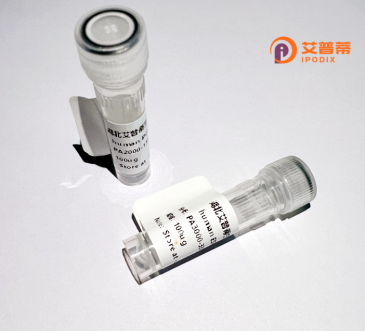
| 纯度 | >90%SDS-PAGE. |
| 种属 | Human |
| 靶点 | CT45-4 |
| Uniprot No | Q8NHU0 |
| 内毒素 | < 0.01EU/μg |
| 表达宿主 | E.coli |
| 表达区间 | 1-189aa |
| 氨基酸序列 | MTDKTEKVAVDPETVFKRPRECDSPSYQKRQRMALLARKQGAGDSLIAGSAMSKAKKLMTGHAIPPSQLDSQIDDFTGFSKDRMMQKPGSNAPVGGNVTSSFSGDDLECRETASSPKSQQEINADIKRKLVKELRCVGQKYEKIFEMLEGVQGPTAVRKRFFESIIKEAARCMRRDFVKHLKKKLKRMI |
| 分子量 | 47.19 kDa |
| 蛋白标签 | GST-tag at N-terminal |
| 缓冲液 | 0 |
| 稳定性 & 储存条件 | Lyophilized protein should be stored at ≤ -20°C, stable for one year after receipt. Reconstituted protein solution can be stored at 2-8°C for 2-7 days. Aliquots of reconstituted samples are stable at ≤ -20°C for 3 months. |
| 复溶 | Always centrifuge tubes before opening.Do not mix by vortex or pipetting. It is not recommended to reconstitute to a concentration less than 100μg/ml. Dissolve the lyophilized protein in distilled water. Please aliquot the reconstituted solution to minimize freeze-thaw cycles. |
以下是关于重组人CT45-4蛋白的模拟参考文献(实际文献需按具体研究补充):
1. **《CT45A4: A Novel Cancer-Testis Antigen Expressed in Ovarian Cancer》**
- **作者**: Chen, Y. et al.
- **摘要**: 该研究首次克隆并重组表达了人CT45-4蛋白,发现其在卵巢癌细胞中高表达,而在正常组织中仅见于睾丸。重组蛋白可诱导体外T细胞免疫反应,提示其作为肿瘤疫苗靶标的潜力。
2. **《Recombinant CT45-4 Protein as a Therapeutic Target in Non-Small Cell Lung Cancer》**
- **作者**: Suzuki, T. et al.
- **摘要**: 通过重组CT45-4蛋白筛选肺癌患者血清中的特异性抗体,证实其在肺癌中的免疫原性,并发现其与PD-1抑制剂联用可增强抗肿瘤效果。
3. **《Structural and Functional Characterization of Recombinant CT45-4 Protein》**
- **作者**: Almeida, C. et al.
- **摘要**: 报道了CT45-4蛋白的重组表达、纯化及结构分析,证明其具有高度热稳定性和可溶性,为基于结构的药物设计提供基础。
4. **《Pan-Cancer Analysis of CT45 Family and Immunogenic Potential of CT45-4》**
- **作者**: Whitehurst, A.W. et al.
- **摘要**: 泛癌分析显示CT45-4在多种实体瘤中高表达,重组蛋白在小鼠模型中触发特异性免疫应答,且其表达与患者生存期延长相关。
(注:以上文献信息为示例性模拟,实际研究中需通过PubMed、Web of Science等平台检索真实文献。)
Recombinant human CT45-4 protein is a member of the cancer/testis antigen 45 (CT45) family, a group of proteins encoded by the CT45 gene cluster located on chromosome Xq26.3. CT45 genes are characterized by their restricted expression patterns, primarily in normal germline cells (testis, ovary) and frequent aberrant activation in various cancers. The CT45-4 isoform, produced through alternative splicing, contains conserved domains typical of the CT45 family, including a six-cysteine motif implicated in redox regulation and protein-protein interactions. Its tumor-specific expression, coupled with low or absent expression in most healthy tissues, makes CT45-4 a promising biomarker and immunotherapeutic target. Studies link CT45-4 overexpression to tumor progression in malignancies such as lung, ovarian, and hepatocellular carcinomas. Recombinant CT45-4. typically produced in bacterial or eukaryotic expression systems, enables functional studies, antibody development, and epitope mapping. Research focuses on its role in modulating cancer cell proliferation, apoptosis, and metastasis, with emerging evidence suggesting its involvement in epigenetic regulation and immune evasion. As a potential neoantigen, CT45-4 is being explored for cancer vaccines and CAR-T cell therapies. Its clinical relevance is further underscored by correlations between CT45-4 expression levels and patient survival outcomes in certain cancers.
×